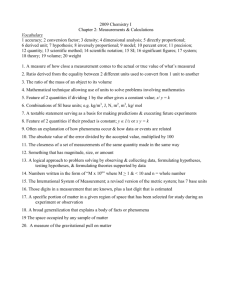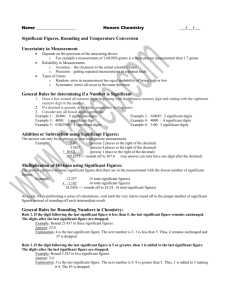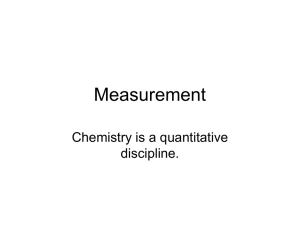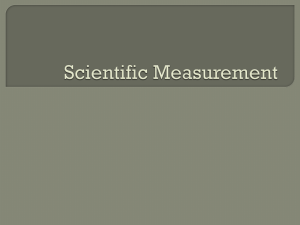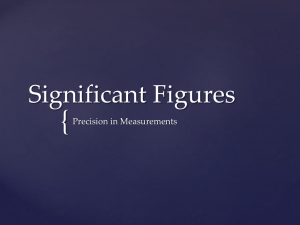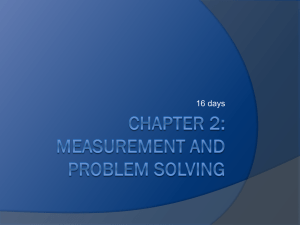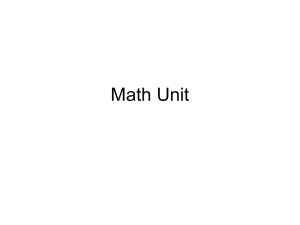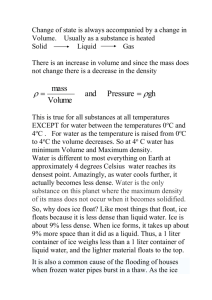Scientific Measurement
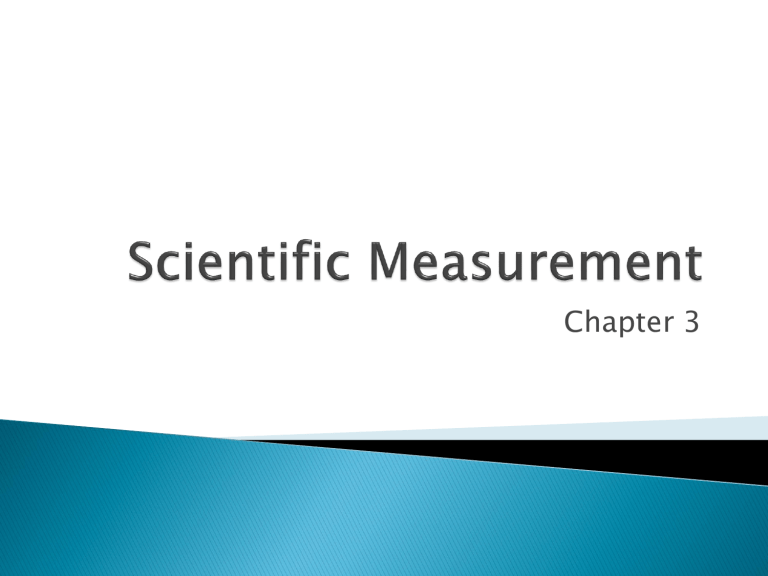
Chapter 3
3.1
3.
1
◦ Measurements are fundamental to the experimental sciences. For that reason, it is important to be able to make measurements, and to use them correctly when calculating answers.
A measurement is a quantity that has both a number and a unit.
◦ Good measurements are accurate, precise, and have low error.
3.
1
◦ Accuracy is a measure of how close a measurement comes to the actual or true value of whatever is measured.
◦ Precision is a measure of how close a series of measurements are to one another.
precise will be the measurements.
The more sensitive the instrument (smaller unit), the more
Good measurements need to be BOTH accurate and precise.
3.
1
3.
1
◦
Error
is the difference between the experimental value and the accepted value.
The accepted value is the correct value based on reliable references (reference tables).
The experimental value is the value measured in the lab.
3.
1
The percent error is the absolute value of the error divided by the accepted value, multiplied by 100%.
See reference table T.
What is a student’s percent error if she found the boiling point of water to be 99.1
°C at STP?
Numbers that are part of a measurement are called significant figures.
Measurements should always be reported to the correct number of significant figures.
Suppose you estimate a weight between 2.4 lb and 2.5 lb to be 2.46 lb. The last digit (6) is an estimate and involves some uncertainty. However, all three digits convey useful information and are called significant figures .
◦ The significant figures in a measurement include all of the digits that are known, plus a last digit that is
estimated
.
◦ Good measurements always estimate one decimal place beyond the calibration of the instrument. In other words,
read between the lines!
Sometimes zeroes are just place holders and are used to locate the decimal point. They are NOT a part of the measurement, and are therefore insignificant.
◦ When doing calculations with measurements, it becomes necessary to round off the answer. This must be done correctly so as not to imply better instrumentation than was actually used.
◦ To round off correctly, you must be able to determine the precision (number of significant figures) in a measurement.
◦ What if you can’t see the instrument used? How do you determine the number of significant figures in a measurement (its precision)?
1.
Nonzero digits are
always
significant.
2.
Leading zeros (occur before any nonzero digit) are
never
significant.
3.
Embedded zeros (between nonzero digits) are
always
significant.
4.
Trailing zeros (after the last nonzero digit) are only significant point.
if
the measurement has a decimal
5.
Counted quantities, physical constants and conversion factors have unlimited significant figures.
◦ When calculating using measurements, the answer should
never
be more precise than the least precise measurement from which it was calculated.
◦ The calculated answer must be rounded to make it consistent with the measurements from which it was calculated.
◦ Rounding calculations depends upon (1) the number of significant figures in the measurements and (2) the mathematical process used to arrive at the answer.
3.
1
◦
Addition and Subtraction
The answer to an addition or subtraction calculation should be rounded to the same number of decimal places (not digits) as the measurement with the least number of decimal places.
3.
1
◦
Multiplication and Division
In calculations involving multiplication and division, you need to round the answer to the same number of significant figures as the measurement with the least number of significant figures.
The position of the decimal point has nothing to do with the rounding process when multiplying and dividing measurements.
3.2
3.
2
◦ All measurements depend on units that serve as reference standards. The standards of measurement used in science are those of the metric system.
◦ The International System of Units (abbreviated SI, after the French name, Le Système International d’Unités) is a revised version of the metric system.
3.
2
◦
◦ What SI units are commonly used in Chemistry?
See reference table D
3.
2
◦ Units of Length
In SI, the basic unit of length, or linear measure, is the meter (m). For very large or and very small lengths, it is more convenient to use a unit of length that has a prefix. See reference table C
3.
2
Common metric units of length include the centimeter, meter, and kilometer.
3.
2
◦ Units of Volume
The SI unit of volume is the cubic meter (m) 3 . A more convenient unit of volume for everyday use is the liter, a non-SI unit.
1 mL = 1 cm3
There are 1000 mL in a liter
3.
2
The volume of 20 drops of liquid from a medicine dropper is approximately 1 mL.
3.
2
A sugar cube has a volume of 1 cm 3 . 1 mL is the same as 1 cm 3 .
3.
2
A gallon of milk has about twice the volume of a 2-L bottle of soda.
3.
2
◦ Units of Mass
The mass of an object is measured in comparison to a standard mass of 1 kilogram (kg), which is the basic SI unit of mass.
A gram (g) is 1/1000 of a kilogram. A penny has a mass of around 5 grams.
3.
2
◦ Units of Temperature
Temperature is a measure of how hot or cold an object is.
Thermometers are used to measure temperature.
3.
2
◦ Scientists commonly use two equivalent units of temperature, the degree Celsius and the Kelvin.
3.
2
On the Celsius scale, the freezing point of water is 0°C and the boiling point is 100°C.
On the Kelvin scale, the freezing point of water is 273
Kelvin (K), and the boiling point is 373 K.
The Kelvin scale starts at absolute zero.
“ Standard Temperature water, 0
°C or 273K
” equals the freezing point of
See reference table A
3.
2
Because one degree on the Celsius scale is equivalent to one Kelvin on the Kelvin scale, converting from one temperature to another is easy. You simply add or subtract 273, as shown in the following equations.
3.
2
◦ Units of Energy
Energy is the capacity to do work or to produce heat.
The joule and the calorie are common units of energy.
3.
2
The joule (J) is the SI unit of energy. We will use this unit this year.
It takes 4.18 joules of heat (or I calorie) to raise the temperature of 1 g of pure water by 1°C.
See reference table B
3.3
3.
33
Because each country’s currency compares differently with the U.S. dollar, knowing how to convert currency units correctly is very important. Conversion problems are readily solved by a problem-solving approach called dimensional analysis.
◦ Chemists often need to convert from one unit of measurement to another. To do this they use
conversion factors
.
3.
3
A conversion factor is a ratio of equivalent measurements.
The ratios 100 cm/1 m and 1 m/100 cm are examples of conversion factors.
3.
3
◦ When a measurement is multiplied by a conversion factor, the unit is changed so the numerical value is different, but the actual size of the quantity measured
remains the same
.
3.
3
◦ Dimensional analysis is a way to analyze and solve problems using the units, or dimensions, of the measurements.
Dimensional analysis uses conversion factors to solve problems.
Given quantities are multiplied by conversion factors so that units cancel out until the desired unit remains.
◦ An exchange student lands on Mars and finds the chemical stockroom. She needs 14 grams of silver
(Ag) for a research project. The attendant asks her
“How many zooms of silver do you need?” Whoops!
Different mass units! The student finds that on
Mars the following units are used: woofs, zings, warps and zooms.
◦ It turns out 9 woofs = 1 gram. Also, 2 zings = 7 warps. 8 woofs = 3 warps and 4 zooms = 3 zings.
◦ How many zooms does the student need?
3.4
If you think that these lily pads float because they are lightweight, you are only partially correct. The ratio of the mass of an object to its volume can be used to determine whether an object floats or sinks in water.
Determining Density
◦ What determines the density of a substance?
Density is the ratio of the mass of an object to its volume.
See reference table T
Each of these 10-g samples has a different volume because the densities vary.
Density is an intensive property that depends only on the composition of a substance, not on the size of the sample.
The density of corn oil is less than the density of corn syrup. For that reason, the oil floats on top of the syrup.
Density and Temperature
◦ How does a change in temperature affect density?
◦ Experiments show that the volume of most substances increases as the temperature increases. Meanwhile, the mass remains the same. Thus, the density must change.
The density of a substance generally decreases as its temperature increases.
